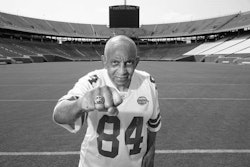In the latest Racial and Gender Report Card from The Institute for Diversity and Ethics in Sport (TIDES) the overall grade for college sport is a C+.
While that C+ does note a small gain between 2017 and 2018, leadership positions in intercollegiate athletics still fail to reflect the diversity of the student-athletes on the fields of play. With a B-, racial hiring has a slight uptick, but gender hiring remains the same at a C+.
At 22.4 percent, the percentage of African-American Division I men’s head basketball coaches remains down from the all-time high of 25.2 percent reported in 2005–06. During the most recent reporting period African-American student-athletes comprised 53.6 percent of the players in Division I Men’s Basketball.
Across sports, there are men coaching women’s sports, but there are currently no women coaching men’s basketball at any level. In Division I Women’s Basketball, 43 percent of the student-athletes were African-American, but only 11.9 percent of the head coaches were African-American women.
“Forty-seven years after the passage of Title IX, nearly 60 percent of women’s teams are still coached by men,” said Dr. Richard Lapchick, director of TIDES and the primary author of The 2018 Racial and Gender Report Card: College Sport (CSRGRC). “That doesn’t make any sense and it’s obviously wrong.”
 Dr. Richard Lapchick
Dr. Richard Lapchick“The Whiteness of the coaching ranks when you look at Divisions I, II and III shows me how far we have to go,” he added.
For more than a decade, Lapchick has advocated for an Eddie Robinson/Judy Sweet rule akin to pro football’s Rooney rule, but said the NCAA says it is unable to do that.
“We had an experience many years ago when they said the same thing about graduation rates,” Lapchick noted. “Then, when the federal government stepped in, there was legislation to publish graduation rates and suddenly the NCAA was publishing graduation rates, including with the racial breakdown.”
“If they can’t or won’t [create a rule], I think we have to put pressure on individual conferences to adopt rules like that,” he added. “Like the state of Oregon has done and successfully transformed who is leading the Oregon schools — both in the coaching ranks and in the administration of those athletic departments.”
Football Bowl Subdivision (FBS) conference commissioners are 100 percent White and predominantly male. There is one White female. In Division I conferences, excluding HBCU conferences, 28 of 30 commissioners were White, nine of them female.
Lapchick noted that alumni certainly have a voice, but that voice has historically focused on creating winning programs rather than building diverse athletic departments. He is looking toward millennials, who are typically more engaged in diversity issues, to become active in encouraging increased diversity in athletic departments and conference offices.
“[FBS conferences] certainly have the power and influence to bring about change in diverse hiring practices if they chose to,” he said.
Other notable points in the CSRGRC is that the percentage of female presidents at the 130 FBS institutions rose from 15.4 percent in 2017 to 16.9 percent in 2018. There were six African-American presidents, six Asian presidents and six Latino presidents. The number of athletic directors of color at FBS schools declined from 22 in 2017 to 20 in 2018.
White men dominated the head coaching ranks on men’s teams, comprising 86.2 percent of all head coaches in Division I. In women’s sports, Whites (both male and female) held 85 percent of the head coaching positions in Division I.
A crucial position that remains overwhelmingly the domain of White men is the sports information director position. In Division I, White individuals held 91.4 percent of the SID positions. Lapchick said this is highly significant and a shift in this position could have far-reaching positive impact.
“It’s a critical position because whoever the sports information director is, it’s the person who is going to make a decision on who’s going to be covered and what the emphasis is going to be both with student-athletes and coaches,” said Lapchick. “Changing that in particular would have a dramatic and quick impact.”
As with all TIDES reports, Lapchick encourages people to be active in voicing their opinions about diversity and inclusion to colleges and universities.
“Let the athletic departments know that they care about equity, inclusion and diversity,” he said. “While they love to see their teams win and want to contribute to that, they also want to contribute to a more equitable workplace in the athletic department.”


















